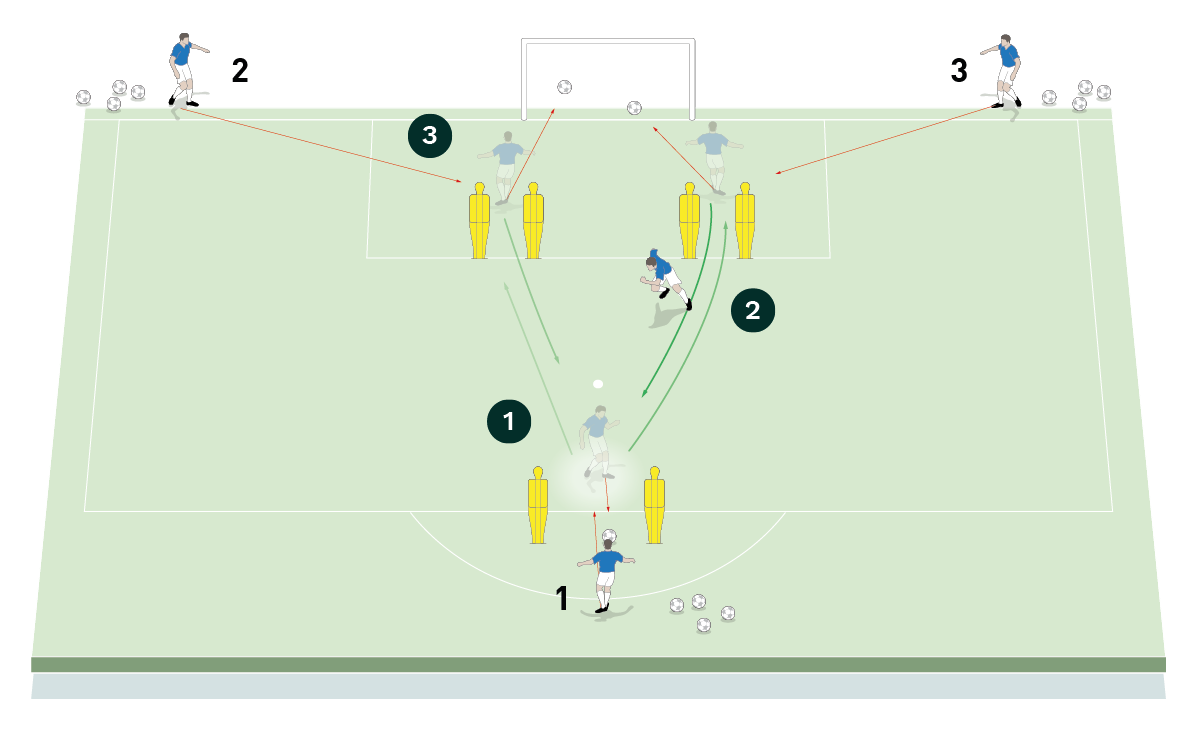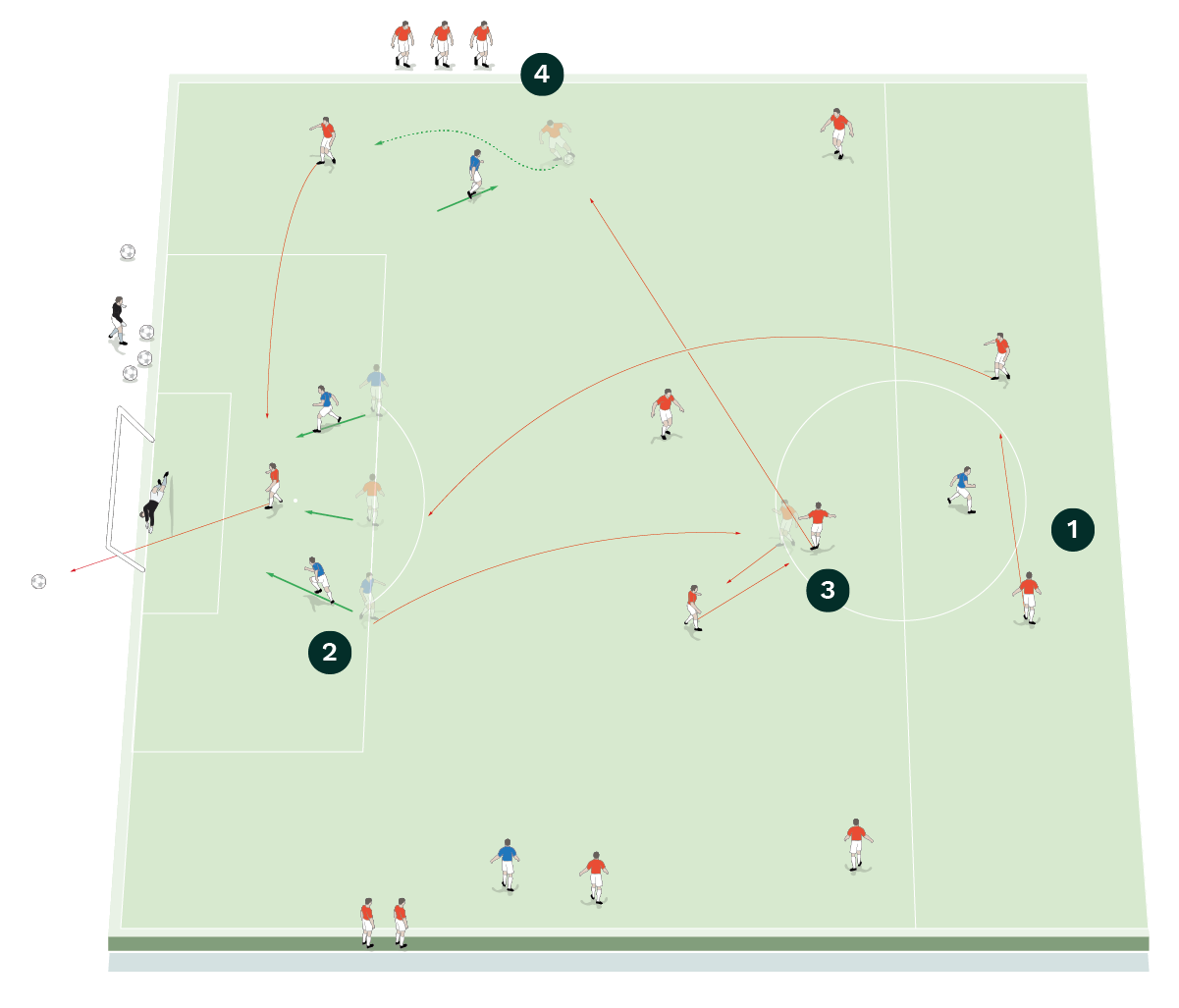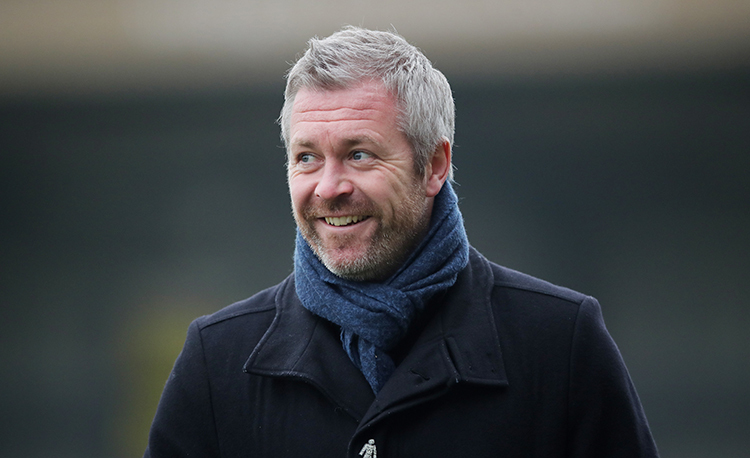You are viewing 1 of your 1 free articles
Individual positional training within a group
| Area | Up to full pitch |
| Equipment | Balls, bibs, cones, 11 mannequins, 2 poles, 2 mini target goals, 2 full size goals |
| No. of Players | 20 players + 2 goalkeepers |
| Session Time | Positional technical practices: 10mins Position specific rondo: 15mins Functional practice: 18mins Small-sided game: 15mins |
We want to expose every player to as many position specific technical actions as possible within a team session that has tactical elements within it. Every minute of the session can be relatable to each individual player and what actions they are expected to perform on the pitch, and tactically what may be expected of them on a match day.
I like this session because it can be manipulated for any formation and any unique style of play, whatever playing principles a coach adheres to.
We class this as a strength session with a physical output emphasis on accelerations and decelerations. With this being the first session of the week, in terms of duration we would aim for a warm-up plus 60 minutes. Most of this session would be delivered within a small area and used on Match Day +3 or Match Day -4.
We would run this session, or an adapted version of it, once a week. We can tweak each element of it to add freshness to the session or adapt certain elements to suit that week’s game plan and opponent.
“We class this as a strength session with a physical output emphasis on accelerations and decelerations”
TECHNICAL PRACTICE FOR DEFENDERS
Following a physical warm-up led by the physical performance coach, the players spend up to 10 minutes working on unit-specific technical drills. The focus is on match-specific technical actions, immersed with accelerations and decelerations.
For the defenders, we set up an area of 20x20 yards with two mini goals at one end, and a player with some balls facing each of the goals at the other end. A mannequin is placed in the middle of the two players, a few yards into the playing area. A pole is placed on each side a few yards from each mini goal, as shown.
A defender starts between the mini goals, a few yards in front of them. The defender sprints towards player 1 and receives the ball, making a defensive header. The defender then sprints around the pole and runs to the mannequin, where they position themselves as if pressing and engaging an opponent in a 1v1. The defender then sprints around the other pole to player 2 and receives the ball to make another defensive header. The defender then sprints to the mini goal facing player 1 to block a pass or shot from player 1, before sprinting to the other mini goal to block a pass or shot from player 2, as shown [1].
[1]

- The defender sprints towards player 1 and receives the ball to make a defensive header
- The defender sprints around the pole and to the mannequin, pressing it as if engaging an opponent in a 1v1
- The defender then sprints around the other pole to player 2 and receives the ball to make another defensive header
- The defender then sprints to the mini goal to block a ball from player 1, before sprinting to the other mini goal to block a ball from player 2
Other defenders rotate in to take their turns. These actions should take 20-30 seconds in total per player, meaning players will perform between five and eight reps each within the ten-minute period.
TECHNICAL PRACTICE FOR MIDFIELDERS
At the same time as the defenders are running their position specific technical practice, the midfielders would run their own drill. We set up a playing area of 20x20 yards with four mannequins and a pole positioned as shown [2].
[2]

- The midfielder sprints around the pole and runs up towards player 1, where they perform two bounce passes on the right of the mannequins, and two on the left
- The midfielder sprints towards player 2, where they perform four technical skills, two on the right of the mannequin and two on the left
- The midfielder then sprints to player 3, where they are fed a ball to head back and are thrown a ball in the air to perform a defensive header
Three players, each with some balls, are stationed next to each of the outside mannequins.
A midfielder starts in the middle of the playing area. They sprint around the pole and up towards player 1, where they perform two bounce passes on the right side of the mannequins, and two on the left side. The midfielder then changes direction and sprints towards player 2, where they perform four technical skill actions, two on the right of the mannequin and two on the left. These could be a side volley or a laced volley, for example, as set by the coach.
The midfielder then sprints to player 3, where they receive a flat ball and head it back, then they receive a throw in the air to perform a defensive header.
Other midfielders would rotate in to take their turns. These actions should take 20-30 seconds in total per player, meaning players will perform between five and eight reps each within the ten-minute period.
TECHNICAL PRACTICE FOR FORWARDS
At the same time as the defenders and midfielders are running their position specific technical practices, the forwards run their own drill.
We set up on the final third of the pitch with a full-size goal in its usual position. Four mannequins are positioned on the six-yard line in front of the goal – two to the right and two to the left. Two more mannequins are positioned in the penalty arc – one either side of the penalty spot. One player is positioned outside of the penalty arc with some balls, while two others are positioned either side of the goal as shown.
The striker starts in front of player 1. They play a bounce pass with the player. The striker then sprints between the mannequins towards player 2 where they receive a pass for a first-time finish.
The striker then sprints back towards player 1 for another bounce pass, then spins and runs between the mannequins towards player 3 to receive a pass for another first time finish, as shown [3].
[3]

- The striker plays a bounce pass with player 1 and then sprints between the mannequins towards player 2 where they receive a pass for a first-time finish
- The striker sprints back towards player 1 for another bounce pass, then spins and runs between the mannequins towards player 3 to receive a pass for a first time finish
- This drill is repeated twice more, with feeds from players 2 and 3 in the air for header and volley finishes
“At the same time as the defenders and midfielders are running their position-specific technical practices, the forwards run their own drill”
This movement is repeated twice more, with balls fed from players 2 and 3 in the air for header or
volley finishes.
Other strikers would rotate in to take their turns. These actions should take 20-30 seconds in total, meaning players will perform between five and eight reps each within the ten-minute period.
POSITION SPECIFIC RONDO
We set up a playing area of 40x25 yards. We’re using 20 outfield players split into two teams of seven (the reds and the blues) and a team of six (the yellows). The reds and the blues each have two centre backs, two full backs, a right winger, a left winger and a striker, while the yellows are made up of six central midfielders.
The blue team starts on the outside of the area, in position. The red team starts inside the area. Three of the yellow team start on the inside of the area, while the other three are resting off the pitch.
The blue team starts with the ball and they aim to keep possession by passing. The red team press and tries to win the ball back. The yellow team are neutrals and play for the team in possession, creating a 4-3-3 when the teams combine, as shown [4a].
[4a]

- The blue team starts on the outside of the area in their positions, with two full backs, two centre backs, two wingers and a striker. They have the ball and they aim to keep possession by passing
- The yellow team are neutral centre midfielders and they play for the team in possession, creating a 4-3-3 when the two teams combine
- The red team press and try to win the ball back
If the red team wins the ball back, they transition to attack – moving into the positions on the outside while retaining the ball. The blue team transition into defence, closing the playing space in the central area as they move into position in the middle, as shown [4b]. The yellow team are now playing for the red team as the reds are in possession.
[4b]

- If the red team wins the ball back, they transition to attack and move into the positions on the outside while retaining the ball
- The blue team transition into defence, closing the central playing space as they move into position in the middle
- The yellows now play for the reds as the reds have possession
The game continues – each time there is a turnover the blues and reds change positions from inside to out or vice versa. Four sets of three minutes each are played and the midfield three changes after each set.
“The game continues for four sets of three minutes and each time there is a turnover of possession the blues and reds change positions from inside to out or vice versa”
FUNCTIONAL PRACTICE
We set up a playing area on two thirds of the pitch with a full-size goal in its standard position. We’re using 20 outfield players and two goalkeepers. The red team has 10 active outfield players and a resting goalkeeper, while the blue team has five outfield players and a goalkeeper in goal. The five remaining outfield players are reds and they are resting off the pitch waiting for a turn to rotate in.
The reds are attacking the goal and they set up in a 4-4-3 formation. The blue team has a back four and a centre forward, with a goalkeeper in goal.
The reds start with the ball and the left-sided centre back plays it to the other centre back, who clips a high ball towards the 18-yard box. The blue centre back defends the ball and the red centre midfielders react to the second ball, securing possession and working it to the red right winger. The winger looks to beat the blue left back in a 1v1 and, if successful, they cross into the box. The reds attempt to score from the cross and the blues must try to defend the goal, as shown [5a].
[5a]

- The reds start with the ball and the left-sided centre back plays it to the other centre back, who clips a high ball towards the 18-yard box
- The blue centre back defends the ball and clears it up the pitch
- The red centre midfielders react to the second ball, securing possession and working it to the red winger
- The red winger looks to beat the blue left back in a 1v1 and crosses into the box
However, if the blue left back wins the ball from the red right winger in the 1v1, the resting goalkeeper plays a new ball to the overlapping red right back. The right back takes a touch before crossing into the box for the red players to attack and blue players to defend, as shown [5b]. As a progression, the red right back can receive an additional pass from the resting goalkeeper whether the red winger wins the 1v1 or not.
[5b]

- Running the same pattern of play as previously, this time the blue left back wins the ball from the red right winger in the 1v1 and clears it out of play
- The resting goalkeeper plays a new ball to the overlapping red right back. The right back takes a touch before crossing into the box
- The red forwards attack the cross and the blue players defend against it
Play then resets. This time play starts with the blue goalkeeper throwing the ball out to the blue right back. The right back drives forward and plays a driven pass into the feet of the centre forward. The centre forward takes a touch and plays the ball to the red centre back. The red team now play an unopposed set pattern of play towards goal, as shown [5c]. As a progression, the blues can become active defenders.
[5c]

- Play resets and this time play starts with the blue goalkeeper throwing the ball out to the blue right back
- The right back drives forward and plays a driven pass into the feet of the centre forward
- The centre forward takes a touch and plays the ball to the red centre back
- The red team now plays an unopposed set pattern of play towards goal
Play then resets again. This time the resting goalkeeper starts play from off the pitch by passing the ball to the deepest lying red centre midfielder. The midfielder plays a pass to the centre forward, who sets the ball for the right-sided centre midfielder. The right midfielder plays a ball through for the left-sided centre midfielder who has made a third man run and takes a shot on goal, as shown [5d].
[5d]

- Play resets again and this time the resting goalkeeper starts play from off the pitch by passing the ball to the deepest lying red centre midfielder
- The midfielder plays a pass to the centre forward, who sets the ball for the right-sided centre midfielder
- The midfielder plays a ball through for the left-sided centre midfielder who has made a third man run and takes a shot on goal
Play then resets again. This time, the resting keeper plays the ball to the red centre forward for a first time finish, as shown [5e].
[5e]

- Play resets again and this time the resting goalkeeper plays the ball to the red centre forward
- The red centre forward finishes with a first-time shot
Each of these plays is run through twice, alternating sides. The players on the outside then swap into the relevant positions. After an eight-minute block, the blues and reds swap roles and play for another eight-minute block.
SMALL-SIDED GAME
We set up a playing area the size of two penalty boxes with a full-size goal in position at each end. Each team has six outfield players and one goalkeeper on the pitch, and four players off the pitch – two end players and two wingers. The players in the middle are unrestricted, the side players have a maximum of two touches, while the end players have a maximum of one touch.
Play starts and restarts from the keeper. Teams can score in three different ways – from open play, from a cross and finish, or from a one-touch finish from the end player’s set. Depending on the game plan, different points values may be given to each type of goal.
In the first example the blue team scores from an end player setting the ball for a striker to finish, as shown [6a].
[6a]

- Play starts and restarts from the keeper. Teams can score in three different ways – from open play, from a cross and finish, or from a one-touch finish from an end player’s set
- In this example the blue team scores from an end player setting the ball for a striker to finish
In the second example, the red team scores a goal from a cross and finish, as shown [6b]. The game is played in four sets of three minutes each.
[6b]

- Here the red team scores a goal from a cross and finish
Progressions can include a team being restricted to score one type of goal, limited touches for the inside players, or one-touch finishes from crosses and cutbacks.
Related Files
Editor's Picks
Deep runs in the final third
Using the goalkeeper in build-up play
Pressing principles
Intensive boxes drill with goals
Penetrating the final third
Creating and finishing
My philosophy
Pressing initiation
Compact team movement
Coaches' Testimonials

Alan Pardew

Arsène Wenger

Brendan Rodgers

Carlos Carvalhal

José Mourinho

Jürgen Klopp

Pep Guardiola

Roy Hodgson

Sir Alex Ferguson

Steven Gerrard
Coaches' Testimonials

Gerald Kearney, Downtown Las Vegas Soccer Club

Paul Butler, Florida, USA

Rick Shields, Springboro, USA

Tony Green, Pierrefonds Titans, Quebec, Canada
Join the world's leading coaches and managers and discover for yourself one of the best kept secrets in coaching. No other training tool on the planet is written or read by the calibre of names you’ll find in Elite Soccer.
In a recent survey 92% of subscribers said Elite Soccer makes them more confident, 89% said it makes them a more effective coach and 91% said it makes them more inspired.
Get Monthly Inspiration
All the latest techniques and approaches
Since 2010 Elite Soccer has given subscribers exclusive insight into the training ground practices of the world’s best coaches. Published in partnership with the League Managers Association we have unparalleled access to the leading lights in the English leagues, as well as a host of international managers.
Elite Soccer exclusively features sessions written by the coaches themselves. There are no observed sessions and no sessions “in the style of”, just first-hand advice delivered direct to you from the coach.









